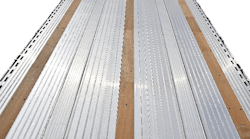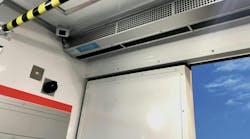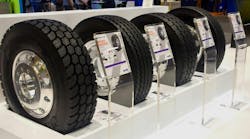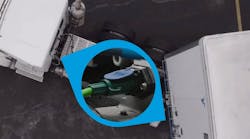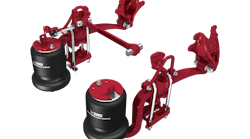STU MacKay, president of MacKay & Company, remembers the good ol’ days in the engine service business: An experienced technician would hold a screwdriver to his ear and then place it against the engine block while it was running and immediately discern which cylinder was the problem and exactly what the problem was.
“Those guys aren’t in the business anymore,” MacKay said. “We’re doing it with diagnostic tools and computers. The service environment has changed significantly. This is not your father’s service business.”
In “How Changing Service Patterns Are Affecting the Aftermarket,” MacKay analyzed the service industry and then turned it over to moderator Gary Cummings, president/CEO of FleetNet America Inc and panelists Brian Mulshine, director of operations technology & innovation for Rush Enterprises; Lori Coleman, fleet manager for Gordon Food Service; and Mike Delaney, president/CEO of WheelTime.
MacKay said everybody’s chasing parts, but service is the $12 billion opportunity nobody wants.
“Service is the key to the parts industry,” he said. “The replacement parts business is not a freestanding business. Its existence is created and controlled by service. Replacement parts demand is zero until someone turns a wrench. Service controls parts. I’m convinced that was true in 1984 and equally convinced that is true in 2014.
“Controlling service controls parts. Controlling service not only locks out other service suppliers;
it knocks out other parts suppliers as well. Service control cuts off competition before it starts. Avoid the gunfight at the OK Corral; dynamite the train before it reaches town. That’s what service control does.
The MacKay Company has done four major surveys on trucks and trailers, the most recent one in 2011. But MacKay believes the data probably hasn’t changed a great deal in the past three years.
MacKay took all the service activity performed on both medium- and heavy-duty trucks, and trailers with container chassis, added the frequency with which they were done and the number of standard labor hours, and it came up with a 2011 total service labor market with 495 million hours.
“A good average for work done for fleets doing their own service internally and work done externally probably averages out to at least $100 an hour, so we have a $50 million opportunity,” he said.
The breakdown: paint and body, 27%; preventive maintenance, 20%; brake, 13%, engine, 9%; electrical, 9%; steering and suspension, 9%; drivetrain, 6%; and all other components, 7%.
By provider: end user, 75%; independent garage, 9%; OE truck dealer, 8%; independent paint and body shop, 6%; and all others, 2%.
MacKay asked survey participants about service outsourcing: How long are you willing to go to get a whole variety of service tasks performed?
For engine overhaul, 38 minutes; paint and body, 35; ABS troubleshooting, 30; electrical troubleshooting, 29; and air conditioning, 28. In terms of miles: engine overhaul, 32; paint and body, 29; ABS troubleshooting, 25; and electrical troubleshooting, 24.
“By and large, there is a limit of about an hour,” he said. “That’s more important in a major metro area where it takes an hour to get across town. If you’re out in the boonies, it’s much more an issue of miles. There are fewer facilities and less ease of accessing facilities.”
Top concerns about outsourcing power unit service work: quality of work and repair, 26%; cost of repairs, 26%; time lost/down time/turnaround time/availability, 24%; reliability/accountability of shop and shop personnel, 8%; quality of parts used/OEM parts, 4%; distance to travel/location, 3%; warranty issues/guarantee, 2%; parts availability, 1%; lack of control, 1%; and service, 1%.
“We have done this for 15 years and have repeatedly found the same thing,” he said. “Operators want to outsource more service. They cannot find acceptable service suppliers. But they are still looking.
“So the opportunities to shift some of that 75% from an in-house shop to a veteran shop—a truck dealer, independent garage, an independent distributor with a service operation—are significant. It’s a $50 million business.”
Some highlights from the Q&A with the panel:
Q: Lori, talk to us about your world. You are a private fleet. Is your organization fleet-focused or is it all about moving food, and fleet is way over here, off to the side?
Coleman: Our core competency is not fleet maintenance. Our core competency and it resources go to our warehousing group because that is our core competency: moving product through the warehouse and getting it out on the road. We do not get the IT reserves we need and resources that are necessary because we are stepchildren.
Q: Pressure points management puts on you to get service performed?
Coleman: Our drivers are our customer. We make sure we keep them happy. Driver turnover in our company is very small. Our turnover rate is somewhere in the 12% range. The big thing we focus on in our shops is productivity. Quality is #1. CSA scores for us are extremely important. We monitor that very closely, and our CSA score for maintenance is 24, thank you. Our guys do a phenomenal job. It’s quality, but also throughput. We need to get that equipment out the door. We don’t handle a job that is more than four or five hours long. We will outsource that.
Q: What percentage of your maintenance is focused on in-house versus outsourced?
Coleman: If you look at it from a cost perspective, 85% of our costs are for in-house and 15% for an external third party. All of our external third party is to dealers for warranty purposes for engines because of failures we see with the new EGR engines.
Q: Why not a higher percentage on the outsource area?
Coleman: We’re a private fleet and we haul food, and the fleet needs to look good. And it needs to not be on the side of the road. I can’t have a reefer breaking down. With our equipment, we make sure when we bring it into the shop that we tell the technician, “When you do service, I expect you to find 10 to 15 things wrong with that unit. I don’t care if the unit has only been in service for six months. We want you to find something wrong.” And we give them the opportunity and time to fix them. Because we’re a private fleet, we have the opportunity to have a spare pool, and that’s 8-10% of the tractor and trailer fleet, which is unique for a private fleet.
Q: What are the issues concerning turning service over to a third party?
Coleman: The quality of service we receive from third-party vendors is the lowest quality we’ve ever seen. Engines today are much more computerized and intricate.
The level we get from technicians at a dealership or another third-party independent is the lowest. When it comes back to us, we have to physically take that unit and have one of our technicians go over it to make sure the job was correct. I’m going to guess at least 60-70% of the time we find errors and have to fix what they do. The #2 problem is communication. When I send it to the vendor, I have to call to follow up: “What’s going on with my vehicle? Have you looked at it? Are you going to put the part on? Has it been approved?” And you get the runaround from any sort of person on the other line that you would get before you finally get that truck back a few days later.
Q: Brian, what’s changing in the industry as you and Rush focus on quality?
Mulshine: At Rush, we just recently put about $40 million into developing a technician tracking system. We’re actually tracking every piece of training and quality of work. We just recently rolled that out. When I look at the investment, we have over 3000 technicians. We average about 60 hours a year per technician on training, times 3000 technicians at about $90 an hour. It comes to about $30 million. We still have to pay them to take the training, and that’s about another $5 million. So when you look at how much we put into training, we’re investing in systems.
Delaney: As trucks get more sophisticated, we’re sort of separating into two separate worlds. A lot of shops you walk into, you will still see 1975 computer technology they’re running the shop with. The tools out there that exist today to bring more people into the service bay create quality. For us, quality was one of the initial founding elements of our network. After that, it’s all about speed and communications. Eighty-five percent of the time the units are in our shops is not spent fixing. Only about 15% is spent on actually fixing. Most of the rest of time is communications and parts needs. ♦

